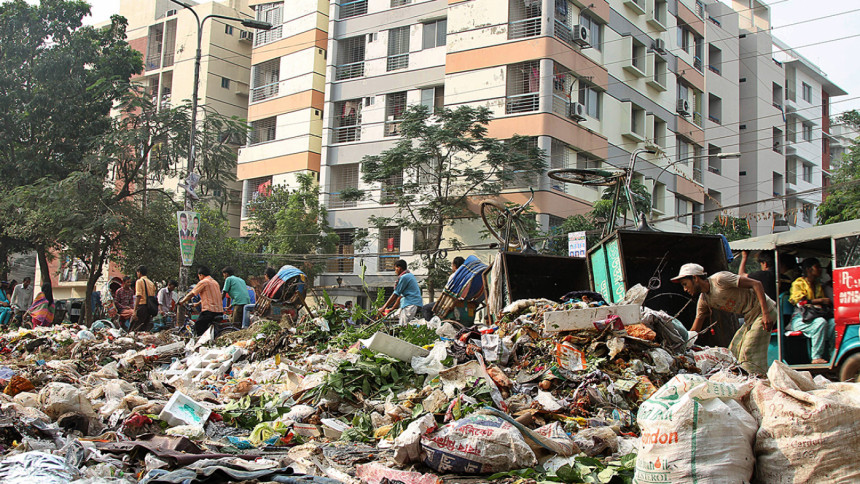Dhaka vs Kolkata

Dhaka has been ranked as the second least liveable city among 140 cities of the world in this year's Global Liveability Index released by the Economist Intelligence Unit.
Only Damascus in war-torn Syria lags behind Dhaka. It means Dhaka is competing with a war torn city to earn the dubious “honour” of being the worst liveable city.
This is not the first time Dhaka has earned this ranking—it did so last year and has been hanging around in the EIU's 10 worst liveable city ranking for several years now.
But it does not need EIU's ranking for those who live in the city to know that Dhaka has been becoming a less welcoming city to live in every year.
Is it because we are overcrowded? Is it because of our constrained resource? Or is it because we Bangalees do not know how to keep our living space nice and liveable?
If we look at Kolkata, the capital of West Bengal and perhaps the best case for comparison, we can clearly see it is neither population, nor resource constraint or cultural habits that contributed to the diminishing liveability of Dhaka.
Ask any old timers of Dhaka—they would sigh and say that Dhaka used to be a beautiful green city even in the seventies. Back then Kolkata was filthy with garbage dumped everywhere on the streets. The air of Kolkata used to reek of garbage. There used to be frequent load shedding and traffic condition was horrendous.
But look how the table has turned. Now Dhaka has all those, not Kolkata. According to a report based on a survey by a non-government organisation published in the Times of India June last year, Kolkata ranks the best among 21 selected Indian cities.
Again you don't even need a survey to compare Kolkata to Dhaka in terms of liveability.
Kolkata has a population of nearly 14 million people (metro population is 4.5 million) while Dhaka has 14 million (with metro population of 7 million). However the sprawl of urban Dhaka is much smaller than that of Kolkata at present.
Kolkata has one basic advantage over Dhaka—it has many more times the streets, both in number and length. The bustling city also has a metro rail service (ours will be coming a few years later) that carries a great number of people around the city.
If you have been to Kolkata, you will find the streets cleaner. They are adequately lighted. Many of the streets do have potholes—but its nothing compared to Dhaka streets.
Kolkata has 48 government hospitals; whereas Dhaka has around 23 (17 of which are specialised). Many Bangladeshis go to Kolkata for better treatment all the time.
The Kolkata government also runs 14 universities—compared to just four (including Sher-e-Bangla Agricultural University and Bangabandhu Sheikh Mujib Medical University) in Dhaka.
The number of taxicabs in Kolkata is no less than 50,000 according to the Indian press—this number would be less than a thousand in Dhaka.
Kolkata is no longer a city of traffic jams— Dhaka is. Kolkata now has dozens of flyovers to ease traffic congestions. Kolkata has complex “One way” street rule enforcement—many streets remain One Way in one direction in the morning and the opposite direction in the evening. The idea of One Way street in Dhaka is utopian at best.
The traffic police in Kolkata have the power on the streets. Nobody fights with the police and commuters rarely disobey traffic rules. The result is visible—you will seldom see a maniacally driven public bus in Kolkata. No bus will stop in the middle of the road at an intersection. No bus will try to crush other vehicles.
It's noteworthy that Kolkata is comparatively safe for women. You can see women on buses even after midnight.
They also kept their famous Gorer Math neat, clean and green. Compared to that, how did we treat our Suhrawardi Udyan?
If you compare the sculptures in the public places in Kolkata with those in Dhaka—you will see that we did not engage real artists to create public art.
Recreation, street food, night life, large shopping malls, apartment lifestyle; on any account, Kolkata is way ahead of Dhaka. And yet Kolkata has the same number of Bangalees we have and we share the culture.
So why do we have a city that appears to be dying? The answer is simple, and this goes with every aspect of the city. People, who do not love our city, plan and run our city. The policymakers are not concerned about the city because they must have disconnected themselves from the services this city provides. For health care they fly to Singapore. For their children's education, they rely on western countries. And when they buy homes, they buy it in Canada or Australia. Otherwise how can they leave this beautiful city rotting?


 For all latest news, follow The Daily Star's Google News channel.
For all latest news, follow The Daily Star's Google News channel. 



Comments